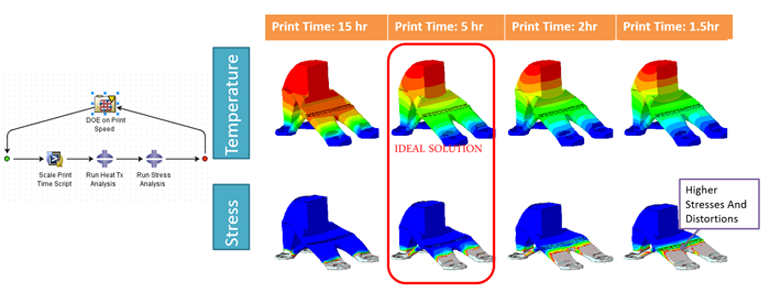
How do you design for manufacturing excellence in the world of Additive Manufacturing?
Table of contents
Additive Manufacturing
It was not that long ago when creating a product prototype meant employing a number of specialist professionals and expensive manufacturing processes with an associated high cost and lengthy lead-time. Nowadays we are told that production components and prototype parts can be reliably created, in a wide variety of materials on a 3D printer in next to no time and with minimal cost.
Recently with the rise in additive metal manufacturing, this technology has started to see a successful shift from prototype to production for major applications, in particular industrial scale components such as tooling, medical and aerospace applications.
Businesses are able at last, to substantiate the many benefits of the Additive Manufacturing process compared to standard fabrication processes whilst handling complex geometry, printing multi parts, light weighting, reducing tooling cost with the effect of delivering a faster product to market.
Design for Additive Manufacturing
However, one has to say the reality of getting the design right for printing industrial scale applications is far from straight forward without understanding the associated challenges such as;
- How Additive Manufactured material properties differ from the previously cast and machined designed components
- The thermal effects that produce residual stresses which can lead to cracking or failure during manufacturing or product life
- The accumulated stresses that lead to distortions which can render a part unusable.
Therefore, in order to close the gap between as designed and as manufactured, we need to consider simulation. This would include;
- Conceptual process optimization: Generate topology that meets functional requirements through optimisation as well as considering using lattice structure
- Calibrate the material: By developing confidence in raw and processed properties as well as capturing phase transformations to understand actual performance
- Print simulation: Capture the real behavior of the print process
- Print process optimization: Optimize the process in order to accurately simulate the development of residual stresses and distortion
- Finally, evaluate in-service performance: Evaluate through simulation how the manufactured part will perform under realistic loading conditions in assembly with other components
Conceptual process optimization
This is usually done by adopting topology optimization tools to help the designer find a concept that would offer optimum weight and stiffness. This process relies on the designer to specify design variables, manufacturing constraints and design objectives. The use of lattice structure is a big plus over standard fabrications processes and offer great saving in weight. Recent development in topology optimization tools have made the optimization of such lattice structure readily available to the designer.
Figure 1: An example of conceptual process optimization workflow
Calibrate the material
The print process affects the final material. Changes in the material properties are the result of phenomena at the micro scale that need to be captured, e.g. for composites: particles or fibers affected by the extrusion process, impacting the directional properties of the material system, for metals: the melting and re-solidification will produce metal phase transformations that impact stiffness and strength.
These are tackled by multi-scale simulation to allow simulation at microstructure and molecules level. In fact, multi-scale simulation is all about bridging the scales; up-scaling and down-scaling.
For example, homogenizing properties from a finer scale to more precisely define phenomenological behaviors at a coarser scale or using results from a coarser scale to drive a detailed calculation at a finer scale.
Print simulation
In order to capture the print process it is important to simulate the actual fabrication process of Additive Manufacturing. Most forms of AM involve the significant addition of heat into the system, either through the laying down of high-temperature molten material or the application of a laser to melt particulate matter or cure a liquid resin. It is critically important to capture heat transfer accurately because it leads to thermal expansion, driving part distortions and stresses. This can be achieved by using a technology to model elements in an inactive state; the elements can be progressively activated according to the translated machine code. The result is the ability to simulate residual stresses and final distortion before printing and avoid printing quality uncertainty.

Print process optimization
There are many print processes that affect the quality of the final product and therefore it is essential to adopt an automated tool to allow the exploration of the best parameters for the job that would help us to reduce residual stresses/potential cracks and deformation. Processes such as laser path, support structure, build orientation, print speed are all targets for optimization.
The Process Composer (within the 3DEXPERIENCE platform) or SIMULIA Isight are both design exploration and process automation tools that would allow us to do this. The integrated software components, data mapping tools and optimization algorithms within these solutions make this task achievable.

In-service performance evaluation
Finally simulating the in-service performance of the product before printing is vital to make sure that all real loading, support, contacts between parts, etc. are all taken into consideration to maximize the assurance of the final quality.
Simulation is the key to manufacturing excellence in the world of Additive Manufacturing
Employing Additive Manufacturing underlines the need to understand, in minute detail, the processes involved within product manufacture. As a significant step forward in disruptive terms, AM represents something that analysis and simulation professionals have been saying for many years. Only now will the business benefits delivered by 3D printing force the requirement to employ advanced simulation into a majority of businesses, and only those most enlightened will see the additional improvements from the co-existence of both design, simulation and manufacturing on one platform that allows collaboration and common data usage.
Discover more about TECHNIA’s PLM Solutions for Additive Manufacturing



